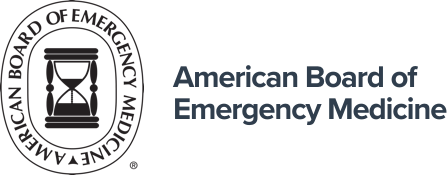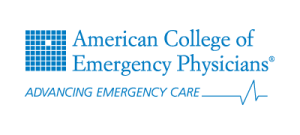How To Prepare for Emergency Medicine Boards (Tips to Ace EM Exams)
2023 ABEM Exam Study Guide
2023 Emergency Medicine Board Exam Study Plan

Emergency Medicine Exam Dates
ABEM Qualifying Exam Dates (ABEM Initial Certification)
Qualifying Exam: October 30 - November 4, 2023
ABEM MyEMCert MOC Program Information
On March 31, 2021 ABEM introduced a new way to stay certified, MyEMCert, designed with the uniqueness of Emergency Medicine in mind, and informed by the preferences of ABEM-certified physicians. This program has replaced the ConCert exam.
MyEMCert will include eight presentation-based modules, each consisting of up to 50 questions. Approximately 80% of the questions will be related to the specific module topic, and 20% related to key advances in the specialty.
MyEMCert Module Listing
- ABDOMINOPELVIC: Presentations may involve the abdomen, pelvis, flank, gastrointestinal, genitourinary system, and early pregnancy complications, as well as abnormal signs and symptoms such as fever, jaundice, pain, rash, hematuria, and nausea/vomiting.
- ABNORMAL VITAL SIGNS AND SHOCK: Presentations may involve almost any condition with a substantial physiologic effect, as well as shock from any pathophysiologic origin.
- TRAUMA AND BLEEDING: Presentations may involve traumatic injuries involving any organ system, surgical complications, and any sources of bleeding (including non-traumatic hemorrhage).
- THORACORESPIRATORY: Presentations may involve the chest wall, heart, lungs, and great vessels. These presentations may include, but are not limited to chest pain, shortness of breath, rash, and other abnormal signs or symptoms.
- NEUROLOGY: Presentations may involve alterations in consciousness resulting from neurologic disease and other transient conditions that may mimic a neurologic etiology.
- SOCIAL AND BEHAVIORAL HEALTH: Presentations may involve psychobehavioral conditions, psychosocial factors, and social determinants of health.
- HEAD AND NECK: Presentations may involve the head, eyes, ears, nose, throat, and neck and may include, but are not limited to, signs and symptoms such as pain, rash, infection, visual changes, and bleeding.
- NONTRAUMATIC MUSCULOSKELETAL; Presentations may involve bones, joints, muscles, and connective tissues. These presentations may include, but are not limited to pain, swelling, numbness, rash, and infections.
MyEMCert will affect physicians differently depending on the year their current certification expires. View ABEM requirements based on when your current ABEM certification expires using the ABEM Reqs tool. MyEMCert module registration is available on your ABEM portal.
Med-Challenger has a dedicated MyEMCert Review Subscription for all eight MyEMCert modules.
MyEMCert modules are organized by content area, allowing you to select, master, and retain information related to specific clinical topics. You may complete the modules in whatever order you choose. Answers with rationales will be provided immediately afterward.
MyEMCert is open book, so study requirements are minimal. However, you must take the modules by yourself.
You will have 4 hours of total time to complete each module. However, you can pause the module while taking it. (NOTE: after 15 minutes your session will time out for security reasons.)
Pilot participants have offered their views on how you might prepare for taking the modules:
- Block off time and choose a location where you can focus
- Use resources and tools you normally would on a shift
- Decide what references you want on hand, including the Key Advance synopses
Other Emergency Medicine Dates & Requirements:
- In-training exam: February 27 – March 2, 2023
Emergency Medicine Certification Requirements:
Preparing for Emergency Medicine Boards
How to Prepare for and Pass the ABEM exam
1. Understand the Structure of the Exam
Step one: Know what material is going to be covered in the exam.
ABEM publishes a content blueprint of the material that will appear on the exam, the primary medical content categories of the blueprint are shown below. This is how we determine which material appears in ABEM board exam simulations.
ABEM selects questions for the exam based on how closely they align with the EM Model, as seen in the EM blueprint. While questions can originate from any content area within the model, some areas are routinely selected. The lists below describe the relative weight given to different elements of the EM Model in constructing the examinations:
Medical Knowledge, Patient Care, and Procedural Skills
- Signs, Symptoms and Presentations: 10%
- Abdominal & Gastrointestinal Disorders: 7%
- Cardiovascular Disorders: 10%
- Cutaneous Disorders: 3%
- Endocrine, Metabolic & Nutritional Disorders: 5%
- Environmental Disorders: 2%
- Head, Ear, Eye, Nose & Throat Disorders: 4%
- Hematologic Disorders: 3%
- Immune System Disorders: 2%
- Systemic Infectious Disorders: 7%
- Musculoskeletal Disorders (Non-traumatic): 3%
- Nervous System Disorders: 6%
- Obstetrics and Gynecology: 3%
- Psychobehavioral Disorders: 2%
- Renal and Urogenital Disorders: 3%
- Thoracic-Respiratory Disorders: 7%
- Toxicologic Disorders: 4%
- Traumatic Disorders: 9%
- Procedures & Skills: 8%
- Other Components: 2%
- Total: 100%
Acuity Frames: Target (± 5%)
- Critical: 30%
- Emergent: 40%
- Lower Acuity: 21%
- None: 9%
Physician Tasks
For this dimension, the Board has assigned the following specific percentage weights to the Modifying Factor of age:
- Pediatrics: 8% minimum
- Geriatrics: 6% minimum
Answering Exam Questions
Each exam question has only one correct answer and each question is worth one point. Only one answer can be selected for each question and you should try to answer as many questions as possible. Each question answered correctly is counted in the total correct score.
Unanswered questions are treated as incorrect. Incorrect answers do not count in the total correct score, nor is there a subtraction from the total correct score for incorrect answers.
Your best strategy for completing the exam is to first complete the initial book, answering all questions with your initial best answer. You may flag questions you would like to return to for later review. The computer system facilitates this test-taking strategy by requiring one initial pass through an examination book before allowing you to select and go to a specific question in that examination book, in any desired order. Once an initial pass-through is completed, you may review all of the questions in that book in any order you choose before selecting the “End Review” button to finish the examination book. Once you exit an examination book by clicking on the “End Review” button, that section of the examination is completed, and you may not re-enter it.
Some questions are not scored and are used only to assure future question quality. These field test questions will not be apparent to the candidate. Including them on the exam allows ABEM to conduct research to determine if the questions are appropriate for scoring future examinations.
2. Know What to Expect on Exam Day
Candidates with approved applications register and pay the exam fee online via ABEM.org. Once you are registered, you will receive an email from ABEM explaining how to schedule your appointment at Pearson VUE. You must then schedule a specific eight-hour examination appointment, during the five-day testing window, at a testing center near you. Locate the nearest Pearson VUE testing center at https://home.pearsonvue.com/About/Locations.aspx.
After check-in, the Pearson VUE test administrator will seat you in the testing room. Each appointment is 8 hours in length. However, only 6 hours and 20 minutes of this time is actual testing time, which is divided into two separately timed testing sessions.
Approximately 1 hour and 40 minutes of the appointment time is devoted to a one-hour scheduled break between the two testing sessions, and several accessory activities related to the exam administration.
Exam Instructions
There is a brief summary of important facts immediately preceding the start of the exam and the second section of the exam after the scheduled break. This summary includes the number of exam questions, procedures for leaving the testing room, and other information related to taking the Qualifying Examination.
Scheduled and Unscheduled Breaks
Take your allowed scheduled break between the two timed testing sessions, if needed.
If you take an unscheduled break during a timed testing session, do not leave the testing center, access outside information, or use a cell phone, as that may invalidate your examination.
- A 1-hour break is scheduled between the two books or sections of the examination, midway through the 6 hours and 20 minutes testing session.
- You can leave the testing building during this scheduled break, but must return in a timely manner or risk losing testing time on the remainder of the examination.
- The timer for the second section of the examination will begin immediately following the hour-long, scheduled break, regardless of whether you have returned to your seat.
- While on an unscheduled break, you may NOT leave the building.
- Accessing prohibited items such as cell phones, laptops, tablet computers, exam notes, or study guides during an unscheduled break is a violation of the ABEM Policy on Examination Irregularities.
Leaving the Testing Room
- You may leave the testing room during the exam appointment after notifying the test administrator. However, the exam timer will remain running while you are out of the testing room, except when you are on the scheduled, hour-long break.
- You are required to provide an infrared palm vein image when you re-enter the testing room.
- If you finish the exam early, you may leave the testing room. Once you check out of the testing center and receive an examination confirmation receipt, you may not re-enter the testing room.
Candidate Survey
A brief, optional survey is available after taking the Qualifying Exam. ABEM encourages you to complete it so the Board can benefit from your experiences. If you choose not to complete this questionnaire, no additional testing time beyond the standard 6 hours and 20 minutes will be allowed for taking the Qualifying Exam itself.
Additional Information
- There is no smoking allowed in the testing center.
- Refreshments are not provided.
- No food or drink is permitted in the testing room. Snacks can be stored in the small lockers provided by the testing center and may be accessed as needed by taking breaks during the exam.
- You cannot make or receive phone calls during your exam administration except during the scheduled, hour-long break.
- Messages will not be given to candidates during their exam unless it is an emergency. If the testing center receives a message for you, the test administrator will give you the message when you have completed your exam and have checked out.
- If you have a question while testing, or if you have finished taking your exam, raise your hand for a test administrator.
After the Exam
Once finished with your exam, return the locker key and dry-erase board to the test administrator. Receive your examination confirmation receipt from the test administrator before leaving the testing center.
3. Plan Out a Study Strategy
Take the time to assess the content you need to cover, and portion it out into manageable increments. Once you’ve grasped the breadth of the material, schedule times throughout your day dedicated solely to the topics and sections you’ve chosen to focus on. Setting a strict schedule and mapping out a plan of attack from the get-go will not only help you manage time and stress, it also ensures that you cover all relevant material.
Starting with topics that are familiar to you will help get you started and reinforce what you know, as well as familiarize you with your study habits
10-14 hours per week for 3 months.
It's highly recommended to spend 10-14 hours a week for three or more months. Take a practice exam simulation as see where your weaknesses are. Work through the individual topics of difficulty to master them, then re-assess overall knowledge with larger exam simulations. The best EM board reviews are built for this.
4. Find a Smart ABEM Question Bank
Feedback from successful examinees suggests that seminars are not very useful. Instead, we recommend you choose an emergency medicine board review course that challenges you and requires your active participation.
Exposing yourself to practice exams early on will warm you up to the content you should expect to see on the exam, as well as help you assess your strengths and weaknesses. Be sure your Emergency Medicine study guide is mapped to the ABEM Blueprint and offers case-based questions that emulate the Q&A format seen on the actual exam.
Things to keep in mind when choosing an Emergency Medicine board review course: As far as board review questions and practice exams go, consider quality as well as the quantity. Insist upon a review that offers thorough, detailed, case-based questions that require involved study and active reading. This is the kind of quality content you're most likely to retain long-term.
Look for lasting value. Once certified, you'll have annual ABEM MOC and CME requirements to fulfill. The ability to earn continuing medical education credits while working through a review product is one of the main added values to pass-guaranteed board reviews.
Finding the best family medicine board review is key and articles such as What is the best Emergency Medicine Question Bank can help. Med-Challenger is a leader in online medical education. Boasting over 3600 detailed, challenging case-based questions following the ABEM exam blueprint, built-in Emergency Medicine CME & ABEM MOC resources, and a 100% pass guarantee, you can't go wrong.
Keep CME and MOC in mind.
Premier ABEM review packages also provide the ability to satisfy AMA and ACEP CME requirements - while you study.

5. Practice & Re-Practice
I start this tip off with a word of advice: As you work your way through review courses and practice exams, expect to fail. Answering incorrectly may be one of the most effective learning tools at your disposal, as it requires remediation, which in turn reinforces learned information and improves recall through active engagement.
“The only real mistake is the one from which we learn nothing.” - Henry Ford
Never expect to get by knowing only the bare minimum. Simply working your way through all content areas relevant to the ABEM Exam Blueprint will not be enough. In times of stress, you don't rise to the occasion - you fall to your highest level of preparation. Go back - do it again. The goal is to assess your strengths and weaknesses. Identifying your knowledge gaps early in the process frees up time for the actual study and review.
6. Identify & Attack Weak Areas
Once you've worked your way through the entirety of your study material several times and familiarized yourself with what areas you are and are not confident in, it's time to focus on the relevant material with which you are least comfortable and familiar.
Consider leaning on an adaptive assessment / prescriptive learning platform, like Med-Challenger. With adaptive learning, not only are you assured to properly utilize all materials available, your time is spent exactly where it needs to be spent with every use, thereby producing a more effective individual review, with no wasted value, all in less time.
And remember: Always keep the ABEM Exam Blueprint in mind!
7. Treat Your Body Right
Preparing for EM boards will push you to your limits – you will be stressed, burnt out, and oftentimes exhausted. But like they say: It’s a marathon, not a sprint. In the long run, it won’t do you any good to sacrifice your physical and mental well-being.
At least every 3 hours, allow yourself a break to relax and unwind. Stay hydrated throughout the day. Remember to eat and nourish your body with healthy meal options. Exercise will help maintain healthy circulation and oxygenation to your brain. Take some time to meditate. And perhaps most importantly, maintain a healthy sleep schedule, especially the week before your exam.
8. During the Exam
The ABEM board typically uses multiple-choice questions that have one best answer. These items have a “stem” that presents the background information necessary for answering the question, which usually comes at the end of the stem. Be sure to read the stem carefully. As you proceed, make note of information that seems especially relevant. Read every answer option carefully. First use the process of elimination to filter out what you know is incorrect, and go from there.
Focus on addressing each question individually. Take a deep breath every now and then.
If you are completely stumped by a question or unsure you answered correctly, flag it and come back later. That having been said, also consider that the first thoughtful answer an examinee makes is usually the best answer. Second-guessing yourself is not likely to help your performance unless you fully realize that you've misread or misunderstood the question. This will help you maximize your time.
Long answers + language match = 😉
Board exam questions usually have tell-tale indicators of what the correct answer option is likely to be. Typically, correct answers tend to be a bit longer and echo language and exact details used in the question stem.
Recommended ABEM Board Review
The Best ABEM Exam Review Continues to Serve YouWe understand the pressure you're surely experiencing knowing the fate of your future career rests on a comprehensive understanding of challenging exam material and peak test performance.
Here's the bottom line: You need to ace this exam, & we at Med-Challenger can make that happen. Our Emergency Medicine Board Review Course has everything you need to practice the various test scenarios you will face during your exam. It's 100% pass-guaranteed with a 99.8% pass-rate.
What's more? Our ABEM board review course also doubles as an ongoing knowledge refresh, MOC requirements aid, and CME credit resources - not just for today, but for every year of your future practice. Get started today!


